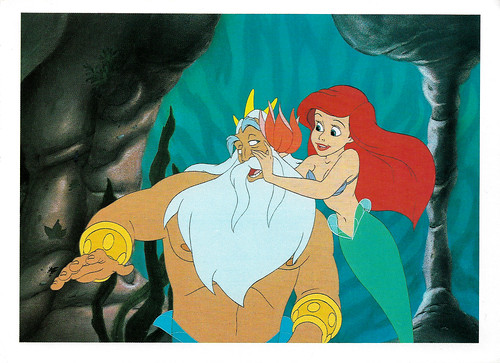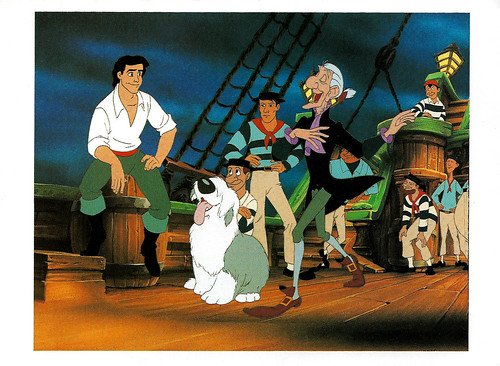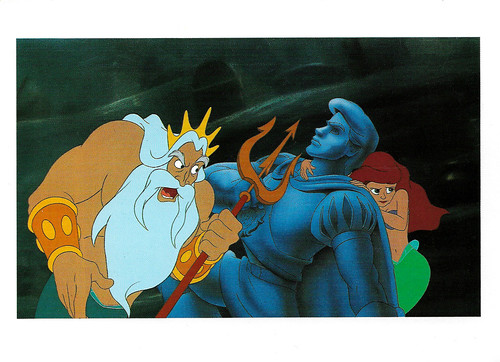
Dutch postcard by Disney Boekenclub, 1998. Image: Disney. Publicity for The Little Mermaid (Ron Clements, John Musker, 1989).

British postcard by Running Press Book Publishers. Image: The Walt Disney Company, 1991. Publicity for The Little Mermaid (Ron Clements, John Musker, 1989). Caption: Triton, the Sea King, gets a flower from his daughter Ariel.

British postcard by Running Press Book Publishers. Image: The Walt Disney Company, 1991. Publicity for The Little Mermaid (Ron Clements, John Musker, 1989). Caption: Prince Eric, Max the dog, and Sir Grimsby, Eric's guardian, celebrate Eric's birthday with the sailors.
An obsession with the human world
The Little Mermaid of the title is the beautiful, rebellious 16-year-old Ariel, one of the daughters of King Triton, whose hidden kingdom lies deep below sea level.
Ariel has an obsession with the human world and all the stuff of humans, something her father absolutely cannot appreciate because he hates humans heartily. He therefore assigns his court musician, the crab Sebastian, to look after her.
One evening, Ariel and the fish Botje see the young and still unmarried Prince Erik aboard a ship. Everyone around Erik is unhappy that he is still not thinking of getting married and starting a family. Ariel instantly falls in love with him.
When the ship runs into a storm and sinks, she rescues Erik from the waves and brings him safely to land. She sings to him the moment he recovers. Although Erik opens his eyes just too late to see her properly, he does hear her.
Afterwards, Erik naturally wants to know who saved him, but he now only knows her heavenly voice. Determined to be with her new love, Ariel makes a dangerous deal with the sea witch Ursula to become human for three days.

British postcard by Running Press Book Publishers. Image: The Walt Disney Company, 1991. Publicity for The Little Mermaid (Ron Clements, John Musker, 1989). Caption: The song, 'Under the Sea', from The Little Mermaid.

British postcard by Running Press Book Publishers. Image: The Walt Disney Company, 1991. Publicity for The Little Mermaid (Ron Clements, John Musker, 1989). Caption: Ariel's sisters tell their father, the sea king, that Ariel's in love.

British postcard by Running Press Book Publishers. Image: The Walt Disney Company, 1991. Publicity for The Little Mermaid (Ron Clements, John Musker, 1989). Caption: Triton, the sea king, reprimands Ariel for falling in love with a human.

British postcard by Running Press Book Publishers. Image: The Walt Disney Company, 1991. Publicity for The Little Mermaid (Ron Clements, John Musker, 1989). Caption: Ariel and Flounder the fish head for her secret grotto.

British postcard by Running Press Book Publishers. Image: The Walt Disney Company, 1991. Publicity for The Little Mermaid (Ron Clements, John Musker, 1989). Caption: Triton, the sea king, and Sebastian the crab discuss Ariel's love life.
Disney's last animated film to be hand-coloured in 1,000 colours
The Little Mermaid (Ron Clements, John Musker, 1989) was the first Disney animated film in 30 years to be based on a pre-existing fairy tale. The last of this kind was Sleeping Beauty (Clyde Geronimi, Les Clark, Eric Larson, 1959).
Disney had already had plans to develop The Little Mermaid in the late 1930s. These plans had existed since the release of Snow White and the Seven Dwarfs (David Hand, William Cottrell, Wilfred Jackson, 1937) but were always postponed due to various circumstances.
The Little Mermaid was Disney's last animated film to be hand-coloured in 1,000 colours. Sherri Stoner was used as a model for Ariel. Animators also based their work on a picture of Alyssa Milano. More than 400 technicians and illustrators worked on the film for 3 years. The film involved more than 1,100 backgrounds and consisted of more than 80 per cent special effects. It took almost a year to make the two-minute storm scene.
The film's script differs significantly from Hans Christian Andersen's original story in several ways, especially the ending. In the fairy tale, for instance, the mermaid turns into foam from grief after her prince marries another. Alan Menken wrote the music for the film, collaborating with Howard Ashman on many of the sung numbers.
The film was a critical and commercial success, garnering $235 million in total lifetime gross worldwide, becoming the sixth-highest-grossing film of 1989. The success of The Little Mermaid caused the film to have several sequels. For instance, the story was expanded with a TV series and the film received two sequels in the form of direct-to-video films: The Little Mermaid II: Return to the Sea (Jim Kammerud, Brian Smith, 2002) and The Little Mermaid: Ariel's Beginning (Peggy Holmes, 2008). Multiple versions of a musical were made, both on Broadway and elsewhere. As part of the Disney Princess Franchise, the character Ariel is one of the most successful Disney characters ever.

British postcard by Running Press Book Publishers. Image: The Walt Disney Company, 1991. Publicity for The Little Mermaid (Ron Clements, John Musker, 1989). Caption: Sebastian the crab is about to become part of Chef Louie's dinner.

British postcard by Running Press Book Publishers. Image: The Walt Disney Company, 1991. Publicity for The Little Mermaid (Ron Clements, John Musker, 1989). Caption: Vanessa the maiden transforms back into Ursula, the sea witch.

British postcard by Running Press Book Publishers. Image: The Walt Disney Company, 1991. Publicity for The Little Mermaid (Ron Clements, John Musker, 1989). Caption: Ariel is teased menacingly by Ursula, the sea witch, in "Poor Unfortunate Souls".

British postcard by Running Press Book Publishers. Image: The Walt Disney Company, 1991. Publicity for The Little Mermaid (Ron Clements, John Musker, 1989). Caption: Ariel struggles as Flotsam and Jetsam, the sea witch's evil pet eels, hold her captive.

British postcard by Running Press Book Publishers. Image: The Walt Disney Company, 1991. Publicity for The Little Mermaid (Ron Clements, John Musker, 1989). Caption: A beaming Ariel smiles at her husband, Prince Eric.
Sources: Wikipedia (Dutch and English) and IMDb.
No comments:
Post a Comment